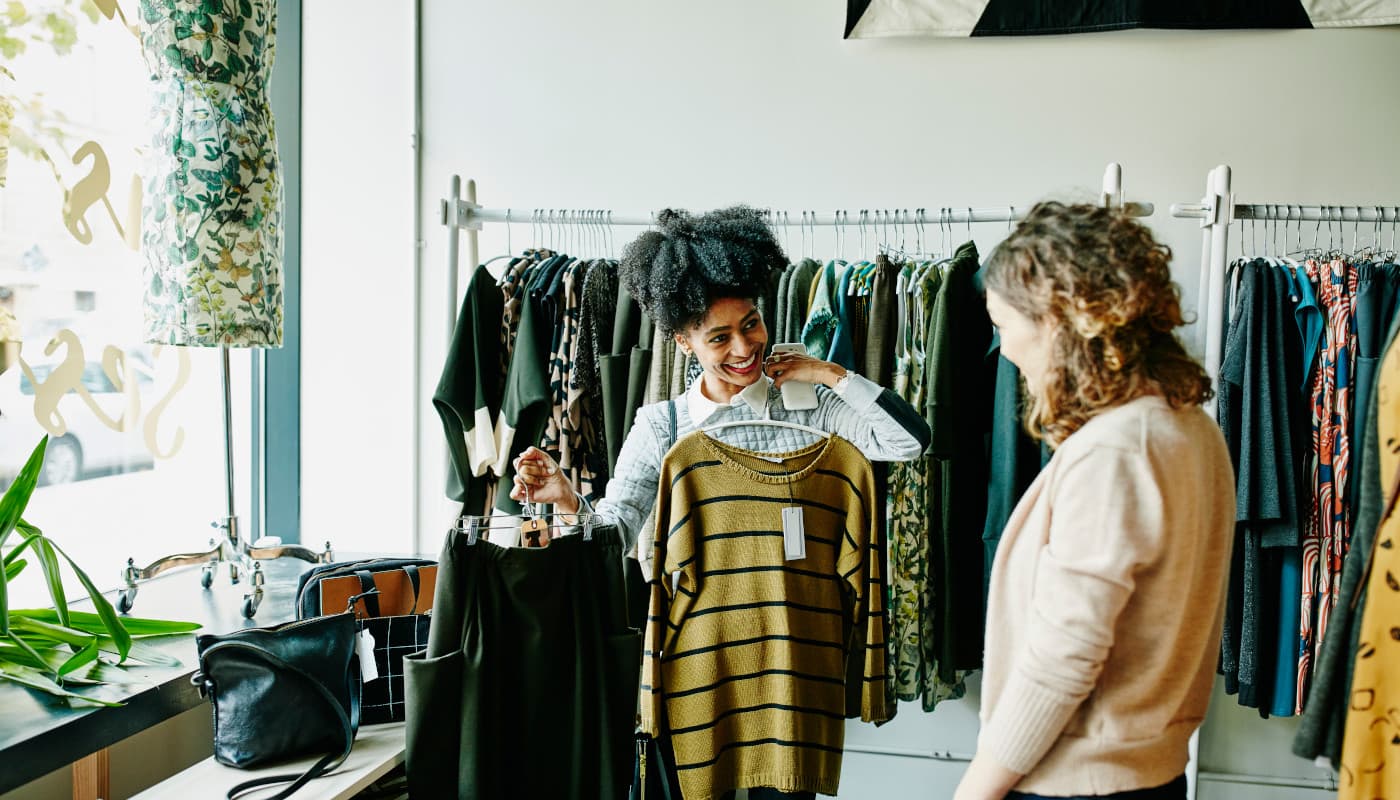How to start a boutique
Editorial Team
6 min read
Although the need to “dress up” took a nosedive in 2020, the demand for clothing and shoes is on the rise. In fact, global apparel sales are expected to grow from $1.74 trillion to $1.94 trillion by 2027. Now’s a great time to step into the apparel and shoes market to capture a piece of the growing demand.
With the right positioning, you can help customers who want to update their wardrobes by starting a clothing boutique. This comprehensive guide outlines the steps involved. steps involved.
How to start an online or brick-and-mortar clothing boutique
Whether you want to know how to start an online boutique or open a physical one, below are some important steps to help you get started.
1. Write a business plan
The business plan phase encompasses several components, including:
- Creating customer personas for your target market. Personas are fictional profiles that represent the types of buyers you’re trying to market to. The better you understand your customers, the more sales you can make.
- Sizing up potential demand to determine if you have a ready market. With physical stores, this means anticipating potential foot traffic. With an online boutique, running limited localized Facebook ads can be a cost-effective way to gauge interest.
- Projecting potential revenues based on your location, market, costs, and sales. A lot of this involves guesswork, but it’s important to lock down these figures as much as possible.
2. Secure financing
The next step requires raising the capital you need to get started. That can’t happen until you understand your startup costs:
- You need inventory before you can make your first sale. Selling on consignment (or through drop shipping) can help keep wholesale costs to a minimum.
- Many boutiques are incorporated as LLCs, but it’s possible to start your first year as a sole proprietorship. Doing so helps minimize costs and paperwork. However, you’ll still need to register as a small business, apply for an Employer Identification Number (EIN), set up a business banking account, and file all relevant taxes.
- If you plan to operate a brick-and-mortar boutique, your costs will also include rent, utilities, a business license, and insurance.
- For online boutique owners, the costs are much lower – with hosting, web design, and computers being the primary expenses.
Startup costs range considerably, with some online boutiques getting off the ground for as little as $500. At the higher end, it’s not uncommon to invest $200,000 to launch a brick-and-mortar location. As a general principle, try to do everything yourself, stay lean, and focus on the essentials.
If you have the funding, you can move onto the next step. Otherwise, you’ll need to raise capital from some combination of family, friends, loans, investors, and even crowdfunding campaigns. In all cases, having a written boutique business plan can help make the pitch for funding easier and faster.
3. Decide on a brand
Based on your audience research, you should have a good idea for the name, color scheme, and style of your budding brand. For many boutique owners, this is the most enjoyable step.
4. Create a storefront
With a physical boutique, finding the right location is critical. You want a spot that is affordable and receives plenty of traffic from your target market. If you are launching an online boutique, your website is your storefront–provided that it also supports digital galleries, online ordering capabilities, and a shopping cart.
5. Get some “threads”
The next step involves sourcing inventory from suppliers and wholesalers. Alternatively, you can design your clothing – provided you have the skills and materials to do so. Either way, procurement costs help to determine what you can charge. You need enough money coming in to partially recover your startup costs and fully cover ongoing expenses.
6. Get paid
Before making sales, you need a way to get paid. Ideally, your boutique POS system should offer several payment options so that customers can check out using their preferred methods. Below are important features to consider before selecting your boutique POS system:
- If running a brick-and-mortar boutique, you need a POS device that supports contactless payments. This helps to reduce unnecessary contact between employees and customers.
- Since online boutiques don’t have to worry about physical contact, your payment environment will need online ordering and eCommerce capabilities.
- You’ll be able to appeal to more customers if your boutique accepts a variety of payment options including credit card, debit card, cash, checks, and mobile wallets.
- However you choose to accept payments, be sure your payment environment adheres to the latest PCI data security guidelines–complete with tokenization and encryption.
At Clover, we’ve helped many small business owners get up and running – with the ability to accept payments quickly and securely. To learn more about our suite of payment tools and POS solutions for boutiques, click here.
7. Generate buzz
With everything finally set up, you’re ready to announce your grand opening. Most boutique owners go on an ad blitz–coupled with social media outreach. How best to connect with your market depends on the target audience. Be prepared to test marketing strategies before finding your stride.
Real-world examples: Broken Spoke Boutique and ChoZen 4 U
Broken Spoke Boutique
Whitney Mayhew, owner of Broken Spoke Boutique in Valentine, Nebraska, took over operations of the small-town women’s clothing boutique from its previous owner and expanded the business by adding new inventory and increasing branding efforts. Mayhew and her husband worked to renovate and redesign the space into the bigger-and-better Broken Spoke Boutique. The duo was able to take advantage of Clover’s inventory tracking and online ordering features to expand their market beyond the small town of Valentine. Mayhew’s husband, who handles running the online store, uses SKU IQ to sync all their inventory between WooCommerce and Clover.
ChoZen 4 U
Corless Berry, owner of the ChoZen 4 U clothing boutique, turned her mobile clothing boutique into a brick-and-mortar business. Berry discovered the benefits of Clover Mini and Clover Go for her boutique POS system solution. She grew her clientele by using Clover’s customer loyalty program. While her Clover system accepts all payment types, Berry uses a cash incentive program through the Clover Flex handheld POS device and offers her customers a discount when they pay with cash, check, or a debit card.
Let us help set up your business to accept payments
At Clover, we can help you design the right payment environment for your new business. Whether you need a full-service POS terminal or an ultra-compact credit card reader, our payment solutions help support the full range of features your boutique needs to start making sales.
To learn more about our easy-to-use payment and POS solutions for boutiques, schedule a free consultation today.
This information is provided for informational purposes only and should not be construed as legal, financial, or tax advice. Readers should contact their attorneys, financial advisors, or tax professionals to obtain advice with respect to any particular matter.
Related Posts
Physical vs digital gift cards: Why offering both is necessary for business success
Get to know your clientele with Customers and Promos
Popular Topics
Stay in touch
Sign up and learn more about Clover.
Thank you for your subscription!
More posts about starting a small business
eBook





